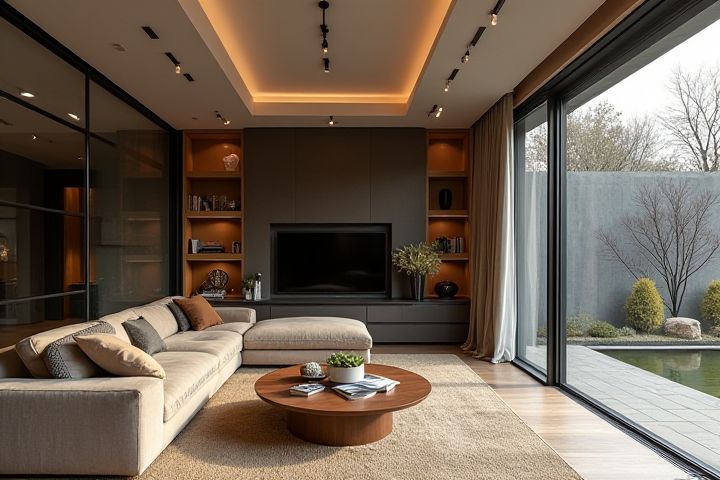
Contemporary house design emphasizes clean lines, open spaces, and a harmonious blend of indoor and outdoor living. The use of sustainable materials, such as reclaimed wood, glass, and steel, plays a significant role in defining contemporary architecture. Large windows and sliding doors not only flood interiors with natural light but also create a seamless connection to the surrounding landscape. Minimalist decor often accompanies contemporary homes, featuring neutral color palettes accented by bold artwork or furniture. Innovative technologies, such as smart home systems and energy-efficient appliances, enhance the functionality and sustainability of contemporary residences.
What Makes A House Contemporary In Design
Open floor plans
Contemporary houses often feature open floor plans that promote seamless flow and connectivity between living spaces. This design approach eliminates unnecessary walls, creating expansive areas that enhance natural light and foster a sense of spaciousness. With typically 1,500 to 3,000 square feet of living space, these homes facilitate easy interaction between the kitchen, dining, and living areas, making them ideal for social gatherings. You can expect to find minimalist furnishings and sleek lines that further emphasize the modern aesthetic.
Large windows
Large windows are a hallmark of contemporary house design, allowing natural light to flood the interior and creating a seamless connection between indoor and outdoor spaces. These expansive glass features often enhance energy efficiency, with options for double or triple-glazing that improve insulation and reduce utility bills. Designers frequently incorporate large windows to showcase scenic views, making them a focal point that elevates the overall aesthetic while maximizing the use of space. When considering a contemporary home, you'll find that these windows not only contribute to the visual appeal but also significantly influence the emotional ambiance of your living environment.
Minimalist aesthetic
A contemporary house often embodies a minimalist aesthetic characterized by clean lines, open spaces, and a lack of clutter, promoting tranquility and focus on essential elements. Utilizing a neutral color palette, such as whites, grays, and earth tones, creates a harmonious atmosphere that enhances natural light and highlights architectural details. Functionality is prioritized through intelligent design choices, such as built-in storage solutions and multi-purpose furniture, fostering an efficient use of space. Large windows and seamless indoor-outdoor connections not only elevate the aesthetic but also enhance the overall living experience, allowing you to enjoy the surrounding environment.
Clean lines
A contemporary-designed house emphasizes clean lines, creating a streamlined and uncluttered aesthetic that enhances both function and form. Typically featuring open floor plans, these spaces utilize large windows to maximize natural light and offer unobstructed views of the surrounding environment. This design approach often incorporates minimalist furnishings and a neutral color palette, emphasizing simplicity and elegance. By prioritizing a harmonious balance between interior and exterior elements, contemporary homes create serene living environments that reflect modern lifestyles.
Natural materials
A contemporary house often features natural materials like wood, stone, and glass, which bridge the indoor and outdoor environments, promoting a seamless connection with nature. For instance, reclaimed wood can be utilized for flooring or accent walls, providing warmth and a sense of sustainability while demonstrating resource conservation. Large windows are common in contemporary designs, allowing natural light to flood the interiors and emphasizing the beauty of natural surroundings. Incorporating elements like green roofs or living walls furthers the contemporary ethos, enhancing energy efficiency and biodiversity, making your home not just aesthetically pleasing but also environmentally responsible.
Neutral color palettes
A contemporary house design often features a neutral color palette, which creates a serene and inviting atmosphere. Shades like beige, taupe, gray, and white provide a versatile backdrop, allowing architectural elements and decorative features to stand out. This color scheme not only enhances the space's brightness and openness but also promotes a sense of harmony and balance. In contemporary interiors, these muted tones are complemented by natural materials such as wood and stone, reinforcing a connection to the surrounding environment.
Integration with nature
Contemporary house design emphasizes a seamless integration with nature, characterized by large windows that invite natural light and framed views of the outdoors. Often, materials such as wood, stone, and metal are utilized to blend the structure harmoniously with its surroundings, fostering a sense of connection to the landscape. Indoor and outdoor spaces are fluidly connected, frequently featuring expansive decks or patios for further immersion in the environment. You may find that eco-friendly features, such as green roofs and native landscaping, enhance energy efficiency while promoting a sustainable lifestyle.
Innovative technology
Contemporary houses often incorporate innovative technology that enhances both functionality and sustainability. Smart home systems enable homeowners to control lighting, heating, and security remotely, creating a more efficient living environment. Energy-efficient appliances and eco-friendly materials contribute to reducing the environmental footprint, while advanced insulation techniques improve energy conservation. You can also find features like solar panels and rainwater harvesting systems, which further exemplify the blend of modern aesthetics with cutting-edge technology in contemporary home design.
Sustainable practices
A contemporary house typically incorporates sustainable practices that align with modern aesthetic and functionality. Features such as energy-efficient windows, solar panels, and green roofs not only reduce energy consumption but also promote environmental stewardship. Using sustainable materials like reclaimed wood, bamboo, and low-VOC paints helps minimize the ecological footprint while enhancing indoor air quality. You can also expect contemporary designs to include ample natural light through strategically placed large windows, which reduces reliance on artificial lighting and further supports sustainability.
Unique architectural features
Contemporary houses often showcase unique architectural features such as asymmetrical shapes, expansive glass walls, and open floor plans that enhance natural light and connectivity with the outdoors. The use of sustainable materials, such as reclaimed wood and concrete, reflects an emphasis on environmental consciousness and innovation. Flat roofs and cantilevered structures provide striking silhouettes, while integrated smart home technology adds modern functionality. Bold colors and mixed textures further distinguish contemporary designs, ensuring each home has its own distinctive character.
